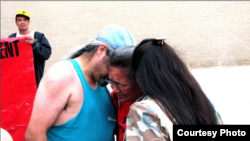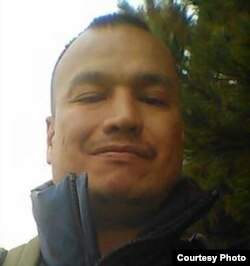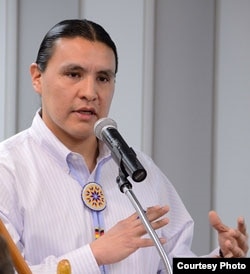The high-profile shooting of an unarmed teen in Ferguson, Missouri last year focused international attention on police using deadly force against African Americans.
But another minority group in the U.S. — Native Americans — also claims they are frequently subjected to excessive force by police, and recent incidents and protests are drawing attention to their cause.
Three Native Americans are reported to have died during arrest or confinement last month.
One of them was Denver resident Paul Castaway, a 35-year-old Lakota Indian with a history of mental illness and alcohol abuse.
“He recently lost his job and he was devastated,” said his mother, Lynn Eagle Feather. On July 12, he returned home from an outing in a state of high agitation and began waving a knife.
She had seen him upset before, but nothing like this day, she said. Frightened, she fled her apartment, her two young grandchildren in tow, and called the police for help.
“I told them, ‘He’s schizophrenic, he’s very angry,’” she said in an interview with VOA.
Police found Castaway, armed with the knife, in a nearby trailer park and gave chase.
“There were about 18 children playing in the parking lot and they were running alongside of my son as the police were chasing him,” his mother said.
She says after Castaway came to a dead end, he ran back into the open street and stopped along a wooden fence. That’s when one of the officers approached him, took aim and fired.
After he fell, Eagle Feather said the officers rolled him over and handcuffed him.
“And he looked at them and said, ‘What’s wrong with you guys?’ That’s the last words that came out of his mouth,” she said.
Denver police officials say Castaway had threatened the officers with his knife. But according to Eagle Feather and a local television report, surveillance footage showed that Castaway had been holding the knife to his own neck.
The Denver Police department did not respond to telephone and email requests from VOA for comment on the Castaway shooting. The officer involved has been removed from active duty, pending an investigation.
Meanwhile, the department has recently completed a major reshuffling of police personnel, citing “complacency” throughout the ranks.
This comes as little consolation to Castaway’s mother, who is looking for answers.
“My son was only a threat to himself,” she said.
She also worries about neighborhood children who witnessed his shooting, including one boy who fainted on the scene.
“He has to go to counseling because he can’t get it out of his head,” Eagle Feather said. “And some of the children are saying that they see my son sometimes, early in the morning, standing there along the fence with his head down.”
Native Americans vulnerable
The United States is home to 565 officially-recognized Indian tribes and other indigenous communities. According to the U.S. Centers for Disease Control, American natives make up less than one percent of the U.S. population.
But Native Americans are victims in nearly two percent of police killings — which makes them statistically more vulnerable to police violence than blacks, according to the Center on Juvenile and Criminal Justice.
Jonathan Blanks, a researcher at the Washington, DC-based CATO Institute, who edits policemisconduct.com, a website that tracks a wide variety of alleged police wrongdoing, says information can be difficult to access.
“The Federal government asks for data on the use of force by law enforcement, but local police agencies aren’t necessarily compliant,” Blank said. “And in some cases, state laws actually prevent police departments from releasing information to the public.”
The FBI publishes data on law enforcement personnel who have been assaulted or killed in the line of duty, as well as cases of justifiable homicide by police. The reports are based on data from 18,000 local and federal law enforcement agencies who voluntarily participate in the program.
But a 2014 Wall Street Journal study of data from more than 100 of America’s largest police agencies found that more than 550 cases of homicide by police between 2007 and 2012 were not included in the FBI data.
The lack of accurate statistics on police violence led D. Brian Burghart, a Reno, Nevada, journalist, to create fatalencounters.org, a site which charts arrest-related deaths every U.S. state.
“We track any manner of deaths — gunshot, Taser, vehicular accidents — anything outside of the jail,” Burghart said. “Unless incidents are reported in the media, chances are we don’t hear about them. I’ve looked at some 8,000 incidents, and I believe that a lot of them, particularly the Native American deaths, don’t get tracked. It’s a giant black hole. It’s almost lucky when it does hit the press.”
‘We never mattered’
Chase Iron Eyes, a Native American lawyer and rights activist with the Lakota People’s Law Project, based in Rapid City, South Dakota, has launched a Native Lives Matter campaign. It is patterned after the #BlackLivesMatter movement formed in the wake of race-related riots in Ferguson.
“It’s very unfortunate that black people are being victimized by police,” he said. “But native people are also being victimized by the very system that’s designed to — should be designed to — protect all Americans,” he said.
“We felt that our voice also needed to be heard and that we needed to deconstruct what we see as a European male-dominated patriarchy and a legal system that was designed to protect European males at the expense of everyone else,” he said.
The controversy is high his home state of South Dakota, where more Native Americans live below the poverty line than in any other U.S. state and where Native Americans are incarcerated at a higher rate than any other race.
While they make up only nine percent of the general population, they represent 29 percent of North Dakota’s prison population.
All this, says Iron Eyes, is part of a pattern of racial discrimination and violence against Indians that dates back generations.
He cites the case of Allen Locke, a native man shot and killed by police in December only a day after he attended a #NativeLivesMatter rally in Rapid City. Police called it a case of “suicide by cop.”
Most recently, in early July, Sara Lee Circle Bear, 24, a Cheyenne River Lakota woman in for a bond violation, complained she was in pain, but was ignored by prison staff who accused her of “faking.” They later found her unconscious in her cell. They transferred her to a nearby hospital, where she was pronounced dead.
Autopsy results issued this week indicated she died from an overdose methamphetamines.
The South Dakota State's Attorney General's Office said it will continue its investigation "as to the source of the methamphetamine."
“There probably will be no follow-up because native lives don’t really matter,” Iron Eyes said.
And they won’t matter, he said, unless stories like hers are brought into the national spotlight.
“Mainstream media that has world wide reach doesn’t usually get the stories that we have because of where we live,” Iron Eyes said. “And if the local or regional media puts a blackout on something, or if the content is detrimental to the image or the reputation of elected officials, like in South Dakota, those kinds of stories don’t get published.”
But Iron Eyes concedes that much of the tension in South Dakota relates back to the August 2011 shooting of two Rapid City police officers by a young native man who had been stopped for a routine traffic violation.
'No conspiracy'
Steve Allender, mayor and former police chief of Rapid City, acknowledged that there are challenges in providing law-enforcement services to Native American community members.
"Native Americans have been through a great deal of trauma over the past 500 years, largely at the hands of white-skinned settlers. A significant component of today's problems are due in some part to our failure to transition from our roles of the past to roles of the present," he told VOA.
Encounters with police officers, who are mostly white or non-native, can bring many of these frustrations to the surface, Allender said.
"There is no doubt Native Americans are overrepresented in our local judicial systems," he said. "Activists simply claim it's racism, even genocide, but I disagree."
There may be ignorance, he admitted, even insensitivity among some white officials.
"But there is no conspiracy to apply heavy-handed governance to one segment of the population."








